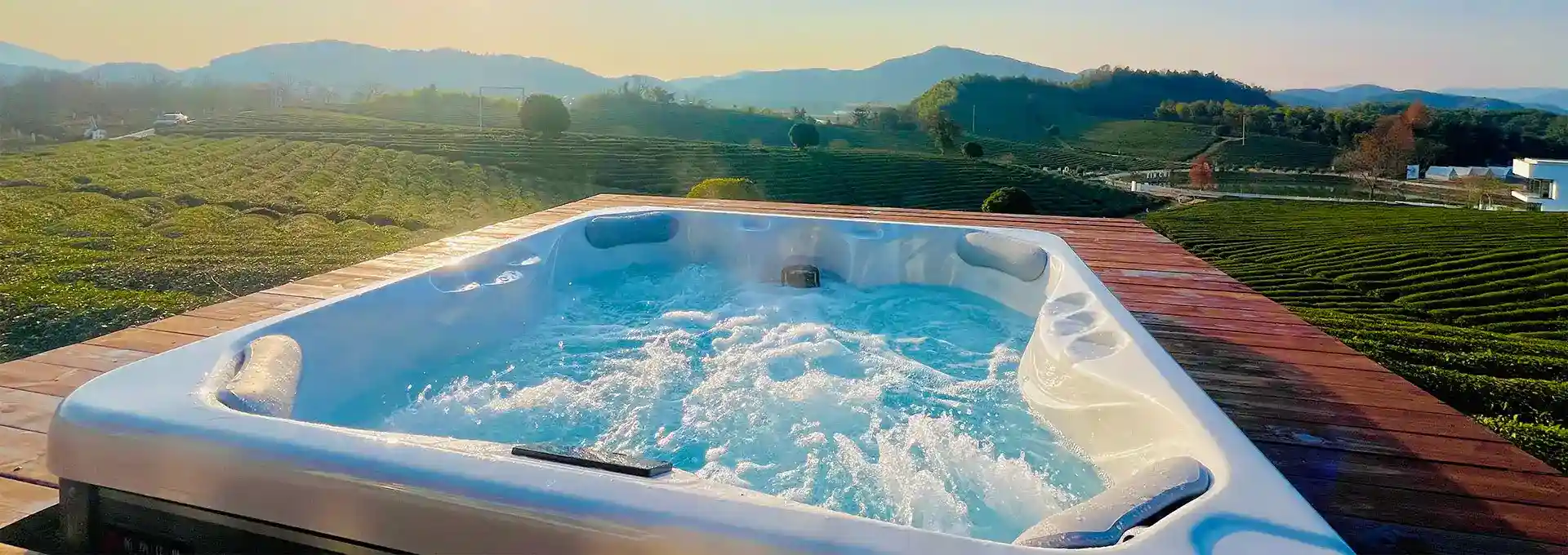How to Reduce Calcium Hardness in a Swim Spa?
2024-06-13 17:38:50
Calcium hardness is a common issue faced by many swim spa and hot tub combo owners. High calcium levels can lead to the formation of scale buildup, cloudy water, and other maintenance problems. Reducing calcium hardness is essential for maintaining the clarity and longevity of your swim spa. In this blog post, we'll explore effective methods to lower calcium hardness levels and keep your swim spa in top condition.
What is Calcium Hardness, and Why is it Important to Control it?
Calcium hardness refers to the concentration of dissolved calcium and magnesium salts in water. While these minerals are essential for human health, excessive levels can cause problems in swim spas. High calcium hardness can lead to scale buildup on surfaces, clogging filters, and reducing the effectiveness of sanitizers. Controlling calcium hardness is crucial for maintaining the clarity and quality of the water, prolonging the lifespan of your swim spa equipment, and ensuring a comfortable and enjoyable experience.
The effects of high calcium hardness can be far-reaching. Scale buildup on surfaces can create a rough, unsightly appearance and make surfaces difficult to clean. Clogged filters can reduce water flow and filtration efficiency, leading to decreased water clarity and potential issues with circulation. Additionally, high calcium levels can reduce the effectiveness of sanitizers like chlorine or bromine, making it harder to maintain proper sanitization levels and increasing the risk of bacterial growth.
How to Test for Calcium Hardness in Your Swim Spa?
Before taking any measures to reduce calcium hardness, it's essential to test the water accurately. There are various testing methods available, including test strips, liquid test kits, and digital testers. Test strips are the most convenient option, providing quick and easy results, while liquid test kits offer more precise readings. Digital testers are the most accurate but also the most expensive. Regardless of the method you choose, follow the manufacturer's instructions carefully and test the water regularly to monitor calcium hardness levels.
It's important to note that calcium hardness levels can fluctuate over time, so regular testing is crucial. Many experts recommend testing calcium hardness levels at least once a week or more frequently if you notice signs of scaling or water quality issues.
Effective Methods to Reduce Calcium Hardness in Your Swim Spa
There are several effective methods to reduce calcium hardness in your swim spa. Here are some popular techniques:
1. Partial Water Replacement: Regularly replacing a portion of the water in your swim spa and hot tub combo with fresh water can help dilute the calcium concentration. This method is effective but can be water-intensive and may require frequent refilling. It's generally recommended to replace around 25-30% of the water every 3-4 months, depending on calcium hardness levels and usage.
2. Use of a Calcium Remover: Calcium removers are chemical products designed specifically to reduce calcium hardness in water. These products work by binding with calcium ions and forming insoluble compounds that can be filtered out or vacuumed from the water. Calcium removers can be effective, but it's important to follow the manufacturer's instructions carefully and not overdose, as this can lead to other water chemistry issues.
3. Ion Exchange System: An ion exchange system is a specialized water treatment system that removes calcium and other minerals from the water. These systems work by exchanging calcium ions with sodium ions, effectively softening the water. Ion exchange systems can be highly effective but require regular maintenance and regeneration with salt or potassium chloride.
4. Reverse Osmosis System: Reverse osmosis systems are highly effective at removing a wide range of contaminants, including calcium and other minerals. These systems use a semi-permeable membrane to filter out impurities, producing high-quality, softened water. While reverse osmosis systems can be expensive to install, they can be a long-term solution for calcium hardness issues in swim spas.
5. Proper Water Chemistry Maintenance: Maintaining the correct pH, alkalinity, and sanitizer levels can help prevent calcium scale buildup and minimize the need for frequent calcium hardness reduction measures. Keeping pH levels between 7.2 and 7.8 and alkalinity levels between 80-120 ppm can help prevent scale formation and ensure sanitizers work effectively.
It's important to note that different methods may be better suited for different situations, and some methods may work better in combination with others. For example, using a calcium remover in conjunction with partial water replacement can be an effective strategy for maintaining calcium hardness levels.
Potential Drawbacks and Considerations
While reducing calcium hardness is essential for maintaining a healthy swim spa and hot tub combo, it's important to be aware of potential drawbacks and considerations associated with each method.
Partial water replacement can be water-intensive and may increase water and energy costs, especially in areas with high water rates or limited water resources. Additionally, frequent water changes can lead to fluctuations in water chemistry, requiring careful monitoring and adjustment.
Chemical calcium removers, while effective, can introduce additional chemicals into the water, which may require extra sanitization or filtration to remove. Some calcium removers may also interact with other water chemistry components, so it's important to follow instructions carefully and test water chemistry regularly.
Ion exchange and reverse osmosis systems can be expensive to install and maintain, and they may require regular regeneration or replacement of filters and membranes. These systems can also waste water during the regeneration or backwashing process.
Proper water chemistry maintenance, while essential, may not be sufficient on its own to control calcium hardness in cases of extreme hardness or heavy bather loads.
It's always recommended to consult with a professional swim spa or pool service provider to determine the best method or combination of methods for your specific situation, water chemistry, and local water conditions.
Conclusion
Controlling calcium hardness is a crucial aspect of maintaining a healthy and enjoyable swim spa and hot tub combo. By understanding the importance of calcium hardness, testing the water regularly, and implementing effective reduction methods, you can ensure your swim spa remains in top condition for years to come. Remember to consult with professionals and follow the manufacturer's guidelines for the best results.
If you want to get more information about this product, you can contact us at info@iparnassus.com!
References:
1. "Calcium Hardness in Swimming Pools and Spas" - Pool & Spa News
2. "How to Reduce Calcium Hardness in Your Hot Tub" - Jacuzzi Hot Tubs
3. "Understanding and Controlling Calcium Hardness in Pools and Spas" - Pentair
4. "Calcium Hardness and Your Swim Spa" - Master Spas
5. "Dealing with Hard Water in Your Hot Tub" - Hot Tub Digest
6. "Calcium Hardness Removal Methods for Hot Tubs" - SpaDepot.com
7. "Calcium Hardness in Swimming Pools: Causes, Effects, and Solutions" - Poolsupplyworld
8. "How to Lower Calcium Hardness in Your Pool or Spa" - Trouble Free Pool
9. "Calcium Hardness and Its Impact on Your Hot Tub" - Hot Tub Club
10. "Calcium Hardness in Hot Tubs: A Comprehensive Guide" - Hot Tub Source
Send Inquiry
Related Industry Knowledge
- Why different hot tubs different prices
- What Causes Cloudy Water in Hot Tubs?
- What Causes a Hot Tub to Crack?
- How to Maintain a Swim Spa with an Oxinator?
- Are Hot Tubs Good for Osteoarthritis?
- Can a Swim Spa be Used as a Hot Tub?
- How to Fill a Hot Tub with Well Water?
- Does a Hot Tub Help with Back Pain?
- How Many Jets for 6 Person Hot Tub?
- How Long Will A Hot Tub Stay Warm Without Power?



